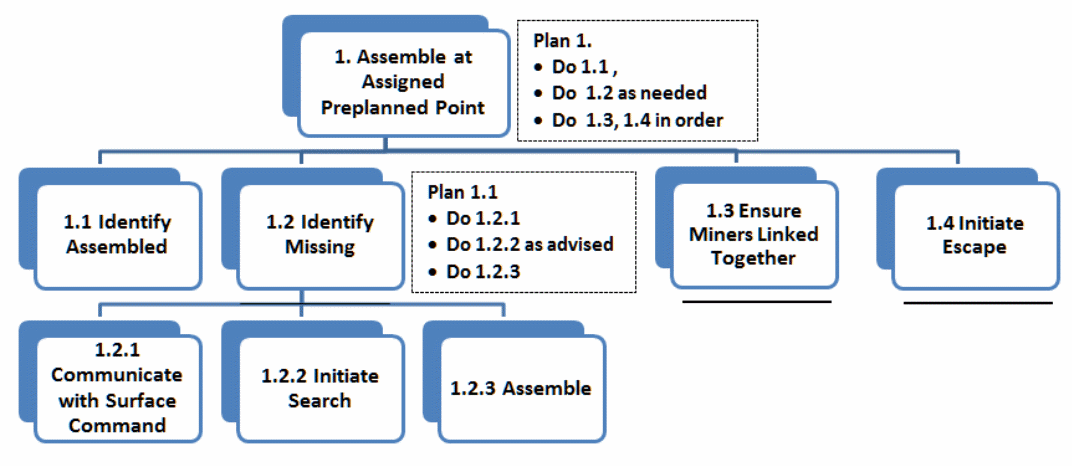HTA Focus group
Emergency Self-Escape for Coal Miners
Attachment F- HTA focus group
HTA Focus Group Sessions
OMB: 0920-1081
Attachment F
HTA Focus Group Session Protocol
Form Approved
OMB No. 0920-xxxx
Exp Date xx/xx/20xx
Hierarchical Task Analysis (HTA) Focus Group Sessions: At each of the two mines, approximately 6 underground miners (for a total of 12) will participate in this type of focus group. A HTA focus group could require up to 12 hours of participation per participant, which could be split across multiple days or sessions.
Following is the protocol for conducting the HTA Focus Group Session::
Obtain verbal participant consent and document their agreement to participate; provide them with the Informed Consent document
Introduce facilitators
Give session introduction:
We are examining mine self-escape. In this workshop, we will be asking you about the tasks that need to be accomplished to successfully self-escape in the face of several different disaster scenarios. The information you provide will be grouped together and referenced for similar and differing opinions. Our discussion will last no more than 12 hours total, across two or three sessions. Your responses to each question will be kept private and we encourage you to not share information that other people provide during the discussion. We are not recording any of your names and in any public release of results, no data will be disclosed that could be used to identify specific individuals. Only NIOSH staff who are involved in collecting or preparing the information for analysis will have access to your answers.
Ask participants to introduce themselves, using first names only
Public reporting burden of this collection of information is estimated to average 12 hours per response, including the time for reviewing instructions, searching existing data sources, gathering and maintaining the data needed, and completing and reviewing the collection of information. An agency may not conduct or sponsor, and a person is not required to respond to a collection of information unless it displays a currently valid OMB control number. Send comments regarding this burden estimate or any other aspect of this collection of information, including suggestions for reducing this burden to CDC/ATSDR Information Collection Review Office, 1600 Clifton Road NE, MS D-74, Atlanta, Georgia 30333; ATTN: PRA (0920-XXXX).
Hierarchical Task Analysis Session/Focus Group
A focus group of Subject Matter Experts (SMEs) will be assembled to conduct the Hierarchical Task Analysis (HTA). The critical tasks identified in a prior session will be examined through the process and questions below. Information during the sessions will be captured on flip-charts and computer.
HTA Process:
Review critical tasks (derived from initial task analysis) with SMEs
Discuss to ensure clarity of tasks and general sequence among them
Generate hierarchy and plans (level, sequence and dependency among sub-tasks)
Decompose tasks by identifying sub-tasks until stopping rules are met
Identify required sequence among tasks and sub-tasks
Confirm accuracy of HTA
Questions for accomplishing HTA process:
To decompose tasks, examine each task and sub-task:
When does this task (sub-task) start? End?
What are the conditions that exist for this task in your mine:
Environmental? (e.g., ergonomic restrictions, physical space restrictions, physical requirements)
Social? (e.g., who is primarily responsible for execution; also team coordination, cooperation, communication)
What tools/equipment/technology are used during this task? Why?
Should we break this task down further? (Example stopping questions: Is this task/sub-task made up of other tasks? To accomplish this task, what other tasks do you need to do? Is it reasonable to stop here and not break the task down further? Would you train this task as a whole, or would you train it in parts?)
To identify plans, identify sequence for each task and its sub-tasks:
In what order are these sub-tasks done? What is done first? Next? What triggers the beginning of a sub-task?
How do you know when a sub-task is completed?
Are any of these sub-tasks discretionary (that is, the task will be accomplished if this task is skipped)?
What sub-tasks, if any, are done (or can be done) at the same time?
What challenges/difficulties might be associated with this sub-task? Do you have any suggestions for how it might be done differently?
To confirm accuracy of decomposition and plans with original and validation group of SMEs:
Here is a self-escape task, with its sub-tasks, to be accomplished in this order. Do you see any sub-tasks missing? Any unneeded? Is the order of accomplishment correct?
Are the starting/completion points correct? The task conditions, including physical demands? Are the tools/equipment or technology used the ones that you would use?
Are there any changes (e.g., to wording) that you would suggest? Are there improvements you might suggest to how this task could be accomplished?
Displays that may be used during working sessions with SMEs
Both tabular and graphical methods of capturing and/or displaying HTA results for SMEs may be used. Examples are shown below.
Table
Task/Subtask |
Initiation/ Completion |
Task Conditions |
Tools/ Equipment/ Technology |
Notes: (e.g., challenges/ problems/ suggestions) |
||
When Started |
When Completed |
Environmental |
Social |
|||
1. Assemble at Assigned Preplanned Point |
|
|
|
|
|
|
1.1 Identify Assembled |
|
|
|
|
|
|
1.2 Identify Missing |
|
|
|
|
|
|
1.2.1 Communicate with Surface Command |
|
|
|
|
|
|
1.2.2 Initiate Search |
|
|
|
|
|
|
1.2.3 Assemble |
|
|
|
|
|
|
1.3 Ensure Miners Linked Together |
|
|
|
|
|
|
1.4 Initiate Escape |
|
|
|
|
|
|
Graph

| File Type | application/vnd.openxmlformats-officedocument.wordprocessingml.document |
| Author | CDC User |
| File Modified | 0000-00-00 |
| File Created | 2021-01-25 |
© 2026 OMB.report | Privacy Policy